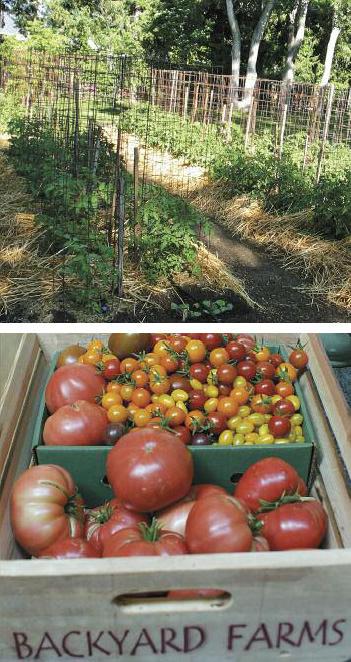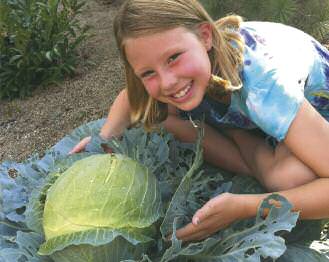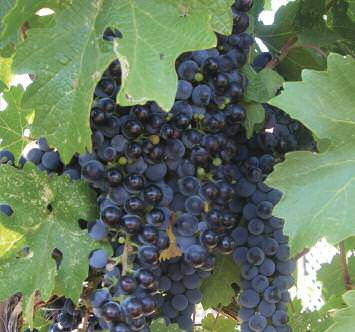cover
GROW TIME
Regional gardeners share their myth-busting growing wisdom.
WRITTEN BY ANN LINDEMANN
PHOTOS BY JEFF ROSS
Virtually every region has its own extraordinary gardening mythology. Sure, it may start with a spade or two of truth, but in the end much of it is just that … myth. Northern Nevada is no exception.
“The biggest myth I hear is, ‘Don’t plant until the snow is off of Peavine,’ which is simply not true,” says Randy Robison, a champion, Reno-based gardener who lectures frequently on Northern Nevada gardening.
He argues that if gardeners wait until the snow melts off this prominent peak, they’ll be “way behind” on planting, especially on the resilient cold-weather edible crops such as carrots, peas, Brussels sprouts, and cabbage. Depending on varieties and weather, planting can begin in March and April.
Another myth that Robison — and scores of other veteran gardeners from Reno, Carson City, Lake Tahoe, and beyond — would like to lay to rest is, “Nothing grows here.”
“You can grow anything here, you just need the right variety — that’s the key,” says Robison, a former emergency room nurse turned bike shop owner (Black Rock Bicycles in Reno) and Jedi-master vegetable gardener, who is known for his drive-by produce drops to unsuspecting-but-grateful North Valley neighbors.
Soil Science
Julie Ruf, who co-owns Carson City’s Greenhouse Garden Center with her husband, David, makes her living providing gardeners with just the nudge they need to pull off a prolific plot in our meteorologically challenged climate.
After advising countless aspiring gardeners throughout the years, Ruf concludes that a few key areas can make the difference between success and failure.
“First of all, people need to be realistic about their time constraints. It’s best to start small with something you can manage,” Ruf says.
She adds that raised-box garden beds of all sizes are particularly good for beginners. That’s a great way to amend the soil in a contained area, and is easier to manage (i.e., no more aching back).
Importantly, Ruf says, vegetable gardeners need to find their place in the sun. Almost every herb and vegetable needs full sun for six to eight hours.
After you’ve determined your gardening venue, it’s time to get busy with the soil. This is a somewhat scientific area where a nursery expert like Ruf can be your best friend.
High-quality gardening soil is a good place to start, she says. However, when establishing a bed, backyard gardeners should amend the soil not only with manure products, but also organic products that contain essential micronutrients such as calcium and magnesium.
Not sure if your soil is primo for veggies?
“It’s not a bad idea to purchase a soil-test kit that can help determine the NPK (nitrogen, phosphorus, potash/potassium) level,” Ruf says.
A Living Palette
A landscaper by trade, Steve Mestre has all the best tools at his disposal, but when it comes to his own yard, it’s his artistic acumen that makes people take notice. Indeed, a few years ago, a freelancer from Sunset magazine discovered Steve and Greta Mestre’s lush two-and-a-half acre, southwest Reno oasis on a community garden tour. Their Monet-worthy garden was later featured in the book, Hillside Landscaping.
When imagining his growing spaces, Mestre doesn’t differentiate between flower and vegetable. He says it’s all about size, color, and texture; a “living palette.”
Still, like every gardener, Mestre is challenged by insects and critters of all kinds.
“It’s a balance with the insects — I don’t want to wipe everything out,” says this owner of Mestre’s Lawn Service. “I basically let nature do what it’s going to do unless it’s killing the plant.”
Mestre describes the vast garden as a “vivacious ecosystem,” which is home to bobcats, mountain lions, bears, rodents, and birds.
“I like to think of it this way: Part of this garden is for us, and part of it is for the ecosystem,” Mestre says.
What’s Mestre’s best advice for frustrated gardeners?
“Gardening is an act of patience,” he says, “and I would tell people to remember to enjoy the process; it’s not an endgame.”

The Art of Adaptation
With everything from skiing to mountain biking, the Tahoe region is beloved for its outdoor recreational offerings … but gardening? Not so much.
However, this didn’t deter Sharon Buss when she moved to Lake Tahoe’s west shore from Southern California 40 years ago.
“I always wanted to farm, but I also loved the mountains where I could ski and mountain bike,” Buss says.
In the end, the lure of the mountains won Buss over. But she didn’t abandon her childhood dream completely, and has managed to create a prolific garden — if not a farm — at an elevation of 6,200 feet.
“We’re Tahoe’s token vegetable gardeners,” she quips.
Sharon and her husband, Michael, live directly across the street from Lake Tahoe in Homewood, Calif. Their home sits at the back of a spacious, sunny lot with the front yard dedicated to four, 4-by-8-foot raised beds.
According to Buss, like Northern Nevada, the Tahoe-Truckee region has its own planting mythology.
“People say, ‘Don’t plant until Mother’s Day,’ but here, the weather is rarely stable then, so I rarely plant before June 1,” she says.
And plant she does. Buss is known for her abundant berry crop, and friends look forward to her annual preserves. Pole beans, snow peas, lettuces, squash, and potatoes also are Buss-garden mainstays.
Like other enterprising tomato-loving Tahoe gardeners, Buss grows hers in portable tubs that can be wheeled in and out of the garage on cold nights. She concentrates her efforts on early-maturing tomato varieties such as grape, plum, and black cream.
Tahoe’s abbreviated growing season doesn’t daunt Buss from growing her favorite produce. Instead, she pays special attention to the seed packages.
“If it says it will take 80 or 90 days to grow, forget it!” Buss says.
Microfarming Magic
Mike Johnson and Sandi Beckett’s growing pursuit on their 4,000-square-foot planting parcel near the Truckee River in west Reno defies conventional labeling. With an annual yield of two tons of fresh produce, it surely can’t be called a garden. But with two full-time, “real-job” health care professionals at the helm, it certainly can’t bear the “farm” moniker. What gives?
“We are urban microgrowers who hit a local market with highly pampered produce such as tomatoes, beans, and onions,” explains Johnson, whose day job is chief operating officer for Community Health Alliance in Reno and who runs Backyard Farms in his free time. “We want to grow the best tomatoes (and beans, lettuce, etc.) in the state of Nevada and help to provide the best produce to locally owned restaurants.”
And just where do they sell their produce? They don’t. Instead, they trade to some of their favorite local restaurants that share their same ideology about the value of local, seasonal produce.
In the morning, they may drop off crates of luscious, warm-from-the-vine tomatoes to Reno culinary notables such as 4th St. Bistro, LuLou’s, Johnny’s Ristorante Italiano, Midtown Eats, Süp, and Bowl. Later in the evening, they’ll head back and use their “credit” to feast on meals prepared with those same vegetables, transformed at the hands of talented chefs with whom they’ve developed full-circle relationships. Obviously, money isn’t the motivation here, but rather a dedication to a blossoming locally sourced food movement.

Restaurateurs aren’t the only ones to benefit from the couple’s growing pursuits. A relaxed bartering system orbits the couple’s universe, from postal carriers to neighbors who may reciprocate with a home brew or baked good.
“It’s about wanting to inspire people to have the confidence to do what we do, maybe not on the same scale, but at some level,” says Beckett, a marriage and family therapist and Backyard Farms’ self-described “produce schlepper.”
What drives gardeners like the ones profiled here to pick up those well-used trowels, spades, and hoes year after year? Perhaps it’s the seminal promise of renewal. Or maybe it’s just how delectable and satisfying that ripe tomato tastes right off the vine, a delicious testament to what is possible.
Thanks to the encouragement of these gardening gurus, Lake Tahoe-based contributor Ann Lindemann plans to plant a petite vegetable garden on June 1 and not a minute before.

A Flavorful Friendship
Anyone can become a certified farmers’ market grower.
With a desire to teach his grandchildren that “Walmart doesn’t grow the food,” Carson City gardener Chuck Malone got a little carried away last year, planting 110 tomato plants, 160 pepper plants, and a myriad of other vegetables.
“I knew I had to do something because it was obvious I couldn’t eat all that I grew,” Malone explains.
Enter 3rd and Curry Street Farmers’ Market Manager Linda Marrone, who encouraged Malone to get his producer’s certification through the Nevada Department of Agriculture so he could sell at the weekly market.
So Malone got busy with the application, and then an official visited his garden to validate that Malone was actually growing what he said he was growing.
He passed with flying colors and, before long, local Carson City restaurateurs started flocking to Malone’s booth and flavorful friendships developed. Sassafras Eclectic Food Joint’s Tony Fish was just such a friend.
“I trust growers like Chuck, whom I can ask to pick out the best fruit or vegetables for me,” Fish says. “The quality of the tomatoes is so much better; they are grown to eat, not to ship.”
For details on obtaining a producer’s certification, contact Peggy McKie at the Nevada Department of Agriculture, Pgmckie@agri.nv.gov or call 775-353-3672.
Chinese Chicken Salad
(courtesy of Kristie Kinder. Serves 6 to 8)
Salad
1 medium head cabbage, shredded or chopped
1 bunch green onions, finely chopped
4 tablespoons butter
2 packages Ramen noodles
2 tablespoons sesame seeds
½ cup slivered almonds
2 to 3 cups chopped, cooked chicken breast (depends on the amount of chicken you like)
Dressing
½ cup canola oil
1 tablespoon soy sauce
⅓ cup sugar
¼ cup seasoned rice vinegar
Salt and pepper to taste
Prepare dressing and set aside.
Crush Ramen noodles and lightly brown in butter over medium heat. Add almonds and sesame seeds. Once Ramen noodles have turned dark golden brown, remove from heat and set aside.
Combine cabbage, green onions, and chicken in large bowl. Add noodle/almond mixture and stir well. Add dressing and stir to coat.
Resources
Greenhouse Garden Center, 2450 S. Curry St., Carson City
775-882-8600, http://www.Greenhousegardencenter.com
Garden Shop Nursery
3636 Mayberry Drive, Reno, 775-825-3527, http://www.Gardenshopnursery.com
Moana Nursery
1100 W. Moana Lane, Reno, 775-825-0600
11301 S. Virginia St., Reno, 775-853-1319
7655 Pyramid Hwy., Sparks, 775-425-4300, http://www.Moananursery.com
Rail City Garden Center, 1720 Brierley Way, Sparks
775-355-1551, http://www.Railcitygardencenter.com
Villager Nursery, 10678 Donner Pass Road, Truckee
530-587-0771, http://www.Villagernursery.com
University of Nevada Cooperative Extension
http://www.unce.unr.edu


